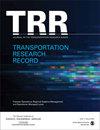富水细砂层盾构尾浆配合比优化及相似度模拟试验
IF 1.8
4区 工程技术
Q3 ENGINEERING, CIVIL
引用次数: 0
摘要
在富水粉砂细砂地层中进行盾构隧道施工时,浆液被地下水稀释后呈流状。稀释后的灌浆充填效果不显著,地表沉降水平很高。本研究以天津地铁11号线04标段为基础,选择传统注浆材料进行响应面法(RSM)试验。RSM分析的目的是分析材料之间的相互作用及其对浆液性能的影响,并优化浆液配合比。比较了不同掺合料对浆液分散阻力和流动性能的影响。最后,研制了盾构同步注浆试验系统,并进行了类似的室内注浆模拟试验,分析了不同外加剂对充填效果的影响,确定了合理的注浆配合比。得到了以下三个结果。(1) RSM适用于浆液性能预测和浆液配合比优化,羟乙基纤维素可以改善浆液性能,提高胶结材料与骨料的粘结性能。(2)增强外加剂掺入可提高浆液利用率,增加隧道顶部扩散距离,有利于盾构尾端空隙的填充。(3)富水细砂地层浆液的最佳配制方案为水胶比0.72,水砂比0.80,粉煤灰掺量5%,膨润土掺量14.94%,外加剂掺量0.8% ~ 0.9%本文章由计算机程序翻译,如有差异,请以英文原文为准。
Optimization of the Grout Mix Ratio and Simulation Test of Shield Tail Grouting Similarities in a Water-Rich Fine Sand Layer
When shield tunneling is performed in water-rich silt and fine sand strata, the grout becomes runny when diluted by groundwater. After dilution, the filling effect of the grout is not significant, and the level of surface settlement is very high. In this study, based on bidding section 04 of Tianjin Metro Line 11, traditional grouting materials were selected to conduct response surface method (RSM) tests. The purposes of the RSM analysis were to analyze the interactions between materials and their influences on grout performance and to optimize the grout mix ratio. Various admixtures were compared to assess the effects of different admixtures and compositions on the dispersion resistance and flow performance of the grout. Finally, a shield synchronous grouting test system was developed, and a similar indoor grouting simulation test was performed to analyze the influences of the different admixtures on the filling effects and to determine a reasonable grout mix ratio. The following three results were obtained. (1) The RSM was suitable for grout performance prediction and grout mix ratio optimization, and hydroxyethyl cellulose could improve the grout performance and increase the bond performance between the cementing material and aggregate. (2) Admixture incorporation enhancement could improve the grout utilization rate and increase the diffusion distance at the top of the tunnel, which would be conducive to filling the gap at the tail end of the shield. (3) The optimal preparation scheme of grout in water-rich fine sand formations included a water–binder ratio of 0.72, cement–sand ratio of 0.80, fly ash content of 5%, bentonite content of 14.94%, and admixture content of 0.8%–0.9%
求助全文
通过发布文献求助,成功后即可免费获取论文全文。
去求助
来源期刊

Transportation Research Record
工程技术-工程:土木
CiteScore
3.20
自引率
11.80%
发文量
918
审稿时长
4.2 months
期刊介绍:
Transportation Research Record: Journal of the Transportation Research Board is one of the most cited and prolific transportation journals in the world, offering unparalleled depth and breadth in the coverage of transportation-related topics. The TRR publishes approximately 70 issues annually of outstanding, peer-reviewed papers presenting research findings in policy, planning, administration, economics and financing, operations, construction, design, maintenance, safety, and more, for all modes of transportation. This site provides electronic access to a full compilation of papers since the 1996 series.
 求助内容:
求助内容: 应助结果提醒方式:
应助结果提醒方式:


